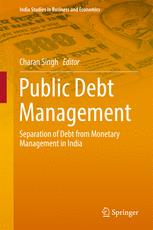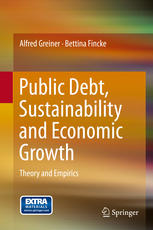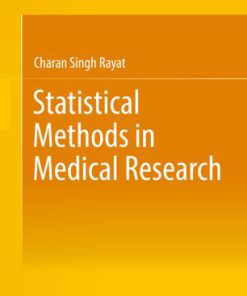Public Debt Management Separation of Debt from Monetary Management in India 1st Edition by Charan Singh 8132236498 9788132236498
$50.00 Original price was: $50.00.$25.00Current price is: $25.00.
Public Debt Management Separation of Debt from Monetary Management in India 1st Edition by Charan Singh – Ebook PDF Instant Download/Delivery: 8132236498, 9788132236498
Full download Public Debt Management Separation of Debt from Monetary Management in India 1st Edition after payment

Product details:
ISBN 10: 8132236498
ISBN 13: 9788132236498
Author: Charan Singh
This book examines the objectives of public debt management and the re-emerging issue of separating monetary policy formulation from fiscal and debt management. The recent Great Recession has resulted in a rethink of the objectives and working of macroeconomics, and in many countries, including India, has led to the scope of fiscal operations being expanded and debt-to-GDP ratios increasing significantly. Consequently, debt management has encountered considerable difficulties, and the need for coordination between monetary and debt management has assumed greater significance. The book discusses the important issue of the independence of central banks and the need for coordination between debt managers, monetary authorities and finance ministries if debt operations are separated from monetary management.
Public Debt Management Separation of Debt from Monetary Management in India 1st table of contents:
1 Introduction
1.1 Separate Debt Management Office in India
1.1.1 Debt Management in India
2 Public Debt Management: Reflections on Strategy and Structure
2.1 Introduction
2.2 Role of Reserve Bank and the Government in Public Debt Management: Legal and Institutional Frame
2.3 Debt Management Strategy
2.3.1 Policy Objectives
2.3.2 Cost Minimisation
2.3.3 Risk Mitigation
2.3.4 Rollover/Refinancing Risk
2.3.5 Exchange Rate Risks
2.3.6 Interest Rate Risk
2.4 Developing the G-Sec Markets
2.5 Institutional Arrangements for Sovereign Debt Management
2.5.1 Post-crisis Lessons
2.6 Concluding Thoughts
3 Debt Management of the Government
3.1 Introduction
3.2 Objectives and Strategy of Debt Management
3.2.1 Strategy
3.3 Debt Profile
3.3.1 Central Government Liabilities
3.3.1.1 Public Debt
Internal Debt
External Debt
3.3.1.2 Public Account Liabilities
3.3.2 General Government Debt
3.3.3 Status
3.3.4 Public Debt—Central Government
3.3.5 External Debt
3.3.6 Maturity Profile of Debt
3.3.7 Profile of New Issuances
3.3.8 Investor Profile
3.3.9 Average Interest Cost
3.4 Active Debt Management
3.4.1 Impact on Fiscal
3.5 Debt Position of State Governments
3.5.1 Composition of State Government Debt
3.6 Sustainability of Debt and Combined Liabilities
3.6.1 Sustainability Indicators of Debt
3.7 Summary and Conclusion
References
4 Cash and Debt Management in States
4.1 Introduction
4.2 Legal Framework
4.3 Trends in State Debt
4.4 Sources of State Debt
4.4.1 Loans from the Centre
4.4.2 External Loans
4.4.3 Loans from National Small Savings Fund
4.4.4 Loans from FIs
4.4.5 Public Account
4.4.6 Market Loans
4.4.7 Investments for Cash Management
4.5 Issues Pertaining to State Debt
4.5.1 Debt Ceiling
4.5.2 Inflexible Sources of Borrowing
4.5.3 Deficit–Borrowing Mismatch
4.5.4 Rates on State Securities
4.6 Have States Fared Better or Worse
4.7 Conclusion
5 India’s Experience with Cash Management
5.1 Introduction
5.2 Historical Facts and Developments
5.3 Recent Developments
5.4 Assessment of the Indian Cash Management System
5.5 Conclusion
References
6 A Separate Debt Management Office
6.1 Introduction
6.2 Some Basics of Debt Management
6.3 Separate Debt Management Office— A Traditional View
6.3.1 Central Bank Independence
6.3.2 Need for Coordination
6.4 Separate Debt Management Office—Post-Crisis Debate
6.5 Debt Management in India
6.6 Important Role of the RBI
6.7 Coordination Between RBI, Government and Markets
6.8 Fiscal Responsibility Legislations
6.9 Need for a Separation of Debt and Monetary Management
6.10 A Discussion on the Views Against Separation
6.11 Conclusion
References
7 Financial Regulation and Independent Debt Management Office
7.1 Introduction
7.2 Rationale for an Independent Debt Management Office
7.2.1 RBI de Jure is not Autonomous or Independent
7.2.2 RBI’s Role in Debt Management is Limited
7.3 What Should Be the Overarching Role and Scope of the IDMO
7.3.1 Market Loans of State Governments
7.3.2 Cash and Investment Management
7.3.3 External Debt
7.3.4 Other Liabilities
7.4 Issues Concerning Organisational Structure of the IDMO
7.4.1 Functions of IDMO
7.5 Relevant Proposals in the Financial Sector Legislative Reforms Commission
7.5.1 Functions
7.5.2 Independence and Other Relevant Issues for the PDMA
7.6 Conclusion
References
8 Fiscal Responsibility and Budget Management Act: An Indian Perspective
8.1 Introduction
8.2 Literature Review and Country Experience
8.2.1 Conceptual Framework
8.2.2 Effectiveness of Fiscal Rules
8.2.3 Fiscal Rules and Procyclicality
8.2.4 Fiscal Rules and Sub-national Governments (SNG)
8.2.5 Cross-country Experiences of Fiscal Rules
8.3 Evolution FRBM Act in India
8.3.1 Genesis of FRBM Bill/Act 2003
8.3.2 Structure and Content of FRBM Act 2003
8.3.3 FRBM Act 2003 and Rules 2004
8.3.4 Amendment to FRBM Act 2003 in 2012
8.3.5 Medium-Term Fiscal Statement (MTFPS)
8.3.6 Review of FRBM Act by FC XIV
8.3.7 Fiscal Road Map Recommended by FC XIV
8.4 Fiscal Developments in India Under FRBM Act
8.4.1 Trends in Deficit Indicators
8.4.2 State Government
8.4.3 General Government (Central and State Governments)
8.4.4 Trends in Liabilities
8.4.5 Trends in Revenue Receipts
8.4.6 Trends in Expenditure
8.5 Emerging Issues
8.5.1 Fiscal Consolidation
8.5.2 Postponement of Quantitative Targets
8.5.3 Quality of Fiscal Consolidation
8.5.4 Introduction of Effective Revenue Deficit a Classic Case of Creative Accounting
8.5.5 Financing Pattern of Fiscal Deficit
8.6 Policy Options
8.6.1 Amendment of FRBM Act in Respect Deficit Rules
8.6.2 Expenditure Pattern in Respect of Capital Outlays
8.6.3 Institutional Arrangement for Repayment of Market Borrowings
8.6.4 Cash Management
8.7 Conclusions
Annex
References
9 Public Debt Sustainability Assessments for Developing Asia
9.1 Introduction
9.2 Public Debt and Fiscal Performance in Developing Asia
9.3 Fiscal Reaction Functions and Asia’s Fiscal Prudence
9.4 SeThe Interest Rate–Growth Differential and the Debt Stabilizing Primary Balance
9.5 Debt Sustainability Analysis Based on Macroeconomic Forecasts
9.6 Assessing the Impact of Shocks in the Deterministic and Stochastic Debt Sustainability Analysis
9.6.1 Standard Debt Sustainability Analysis Stress Tests
9.6.1.1 Stochastic Simulations
9.7 Conclusion
Appendix 9.1: Data Issues
Appendix 9.2: Data Availability and Sources
Appendix 9.3: Regression Analysis Samples and Functions
Appendix 9.4: Estimating Fiscal Reaction Functions
Appendix 9.5: Assumptions Underlying the 2011–16 Baseline Projections
Appendix 9.6: Data Issues in Stochastic Debt Sustainability Analysis
Appendix 9.7: The Stochastic Simulation Analysis
References
10 Round Table
10.1 Introduction
10.2 Discussion
People also search for Public Debt Management Separation of Debt from Monetary Management in India 1st:
separation debt
public debt offering
a debt management plan is
debt management of the federal government includes
what is the purpose of a debt service fund
Tags: Public Debt, Management Separation, Monetary Management, India, Charan Singh
You may also like…
Business & Economics - Management & Leadership
Spirituality in Management: Insights from India Sushanta Kumar Mishra
Jurisprudence & Law - Constitutional Law
Politics & Philosophy - Government & Politics
Public Debt Sustainability and Economic Growth Theory and Empirics 1st Edition Alfred Greiner
Uncategorized
Student Debt and Political Participation 1st Edition by Sylvia Nissen ISBN 3319963228 9783319963228
Business & Economics
Fiscal Policies in High Debt Euro-Area Countries 1st Edition Antonella Cavallo
Business & Economics
Public Debt Dynamics of Europe and the US 1st Edition Dimitris N. Chorafas (Auth.)
Medicine - Others
Business & Economics
Sustainability and Optimality of Public Debt 2nd Edition Michael Carlberg












